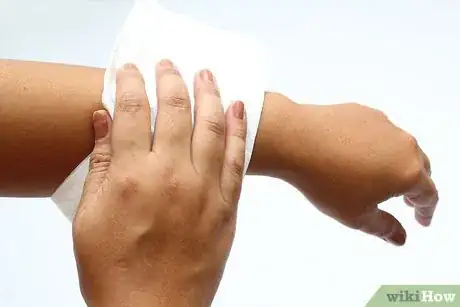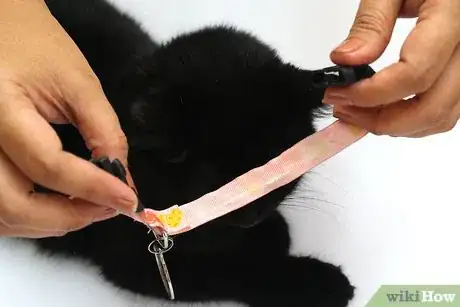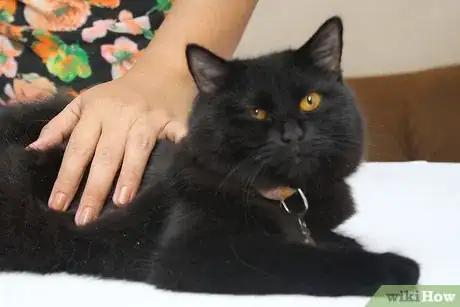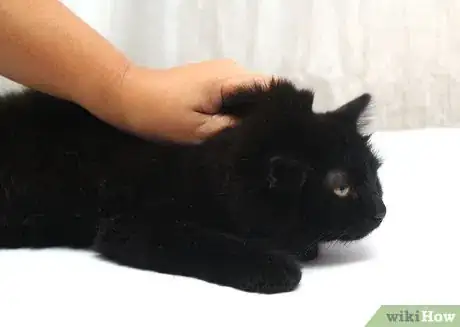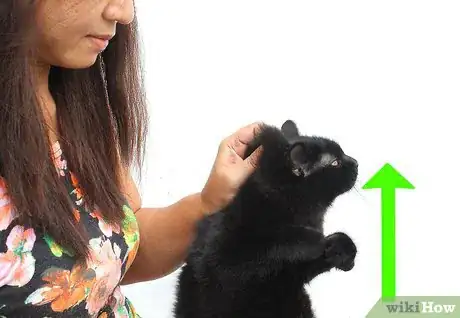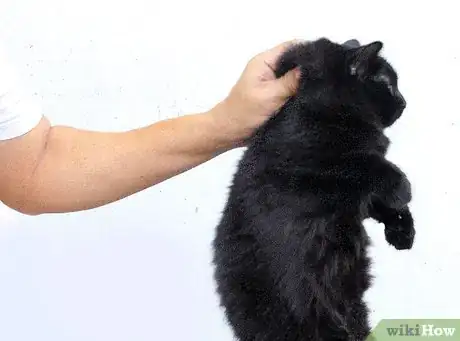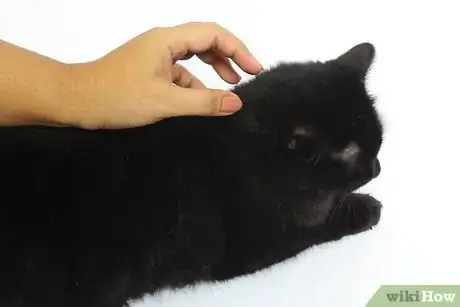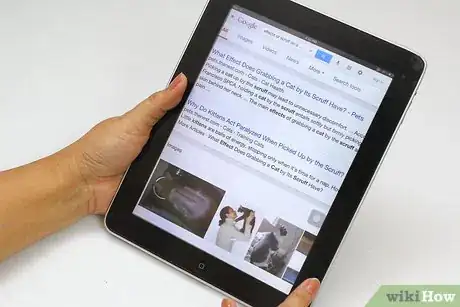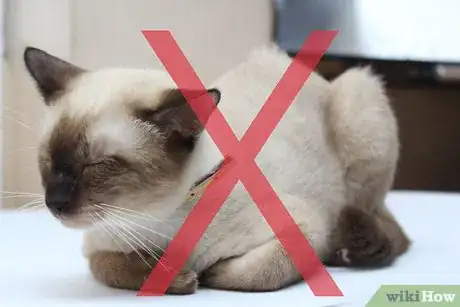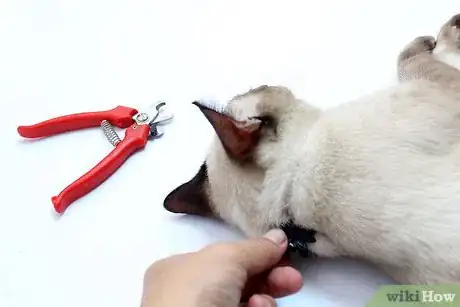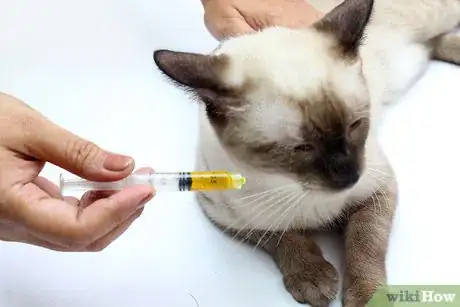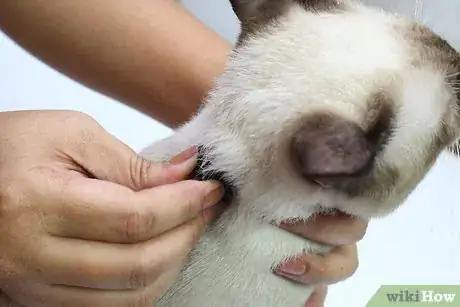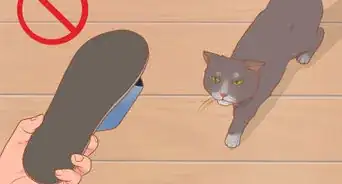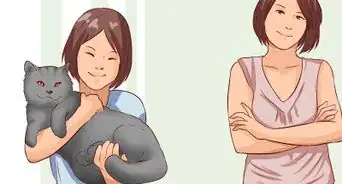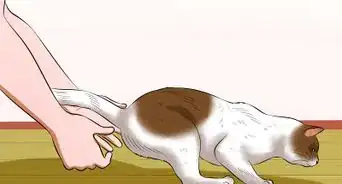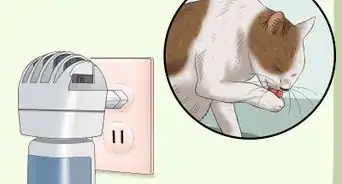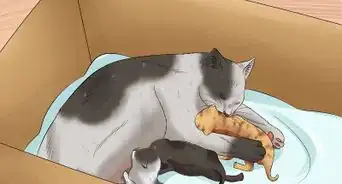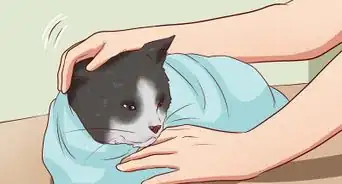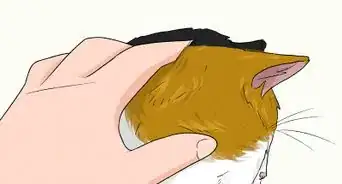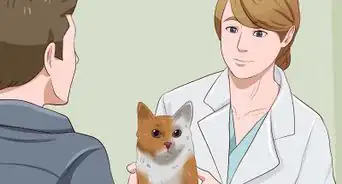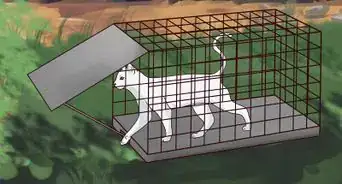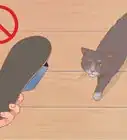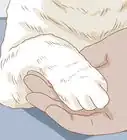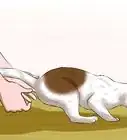This article was co-authored by Brian Bourquin, DVM. Brian Bourquin, better known as “Dr. B” to his clients, is a Veterinarian and the Owner of Boston Veterinary Clinic, a pet health care and veterinary clinic with three locations, South End/Bay Village, the Seaport, and Brookline, Massachusetts. Boston Veterinary Clinic specializes in primary veterinary care, including wellness and preventative care, sick and emergency care, soft-tissue surgery, dentistry. The clinic also provides specialty services in behavior, nutrition, and alternative pain management therapies using acupuncture, and therapeutic laser treatments. Boston Veterinary Clinic is an AAHA (American Animal Hospital Association) accredited hospital and Boston’s first Fear Free Certified Clinic. Brian has over 19 years of veterinary experience and earned his Doctor of Veterinary Medicine from Cornell University.
There are 8 references cited in this article, which can be found at the bottom of the page.
wikiHow marks an article as reader-approved once it receives enough positive feedback. In this case, several readers have written to tell us that this article was helpful to them, earning it our reader-approved status.
This article has been viewed 556,219 times.
The loose skin around a cat's neck is called the scruff. When done properly and only when necessary, scruffing a cat (holding a cat by its scruff) is an effective method of restraint, although it may look uncomfortable or even painful to the cat. There is a right way and a wrong way to hold a cat by the scruff. Learning and practicing the right way will help you become more skilled at safely restraining a cat.
Steps
Safely Scruffing Your Cat
-
1Remove any scents from your body that may be offensive to your cat. Strong-smelling perfumes or colognes may be bothersome to him. The scent of a dog may be especially unsettling.[1]
-
2Allow your cat to become comfortable with you before you try to scruff him. Calmly petting him and allowing him to rub up against your hand will relax him. You may need to spend extra time on this step, depending on if your cat has a calm or skittish temperament.[2]Advertisement
-
3Remove your cat's collar, if he has one. A cat can be held by the scruff with a collar on, but this is not recommended unless you are experienced with handling cats in this way. Although the scruff is flexible, the collar is not, and you might tighten the collar around his neck by accident.
-
4Place your cat on a supportive surface. Having your cat on a sturdy and even surface, such as a table or counter top, will allow you to scruff him more easily.[3] You could also use the floor as a supportive surface, if your cat seems to be more comfortable on the floor.
-
5Scruff your cat when he is relaxed and awake. Rest your hand at the back of your cat’s neck and gently grasp the loose skin in this area with your entire hand. Grasp as close to the ears as possible to lessen the chances that your cat will struggle or attempt to bite you.[4]
- Your cat’s ears should go back slightly when you grasp the skin right behind the ears. This will let you know that you are grasping in the right place.
- When you tighten your grasp, the skin should still feel relatively loose in your hand. If it feels tight, you may have grasped too much skin; loosen your grip slightly. Your cat will probably let you know if you are holding the skin too tightly.
- Do not grab too little scruff. This could cause you to pinch your cat’s skin. Re-adjust your grip to pick up more skin.
- Unless your cat is very aggressive, you should notice that he doesn't mind the grasping at all; he might even become very still. Sometimes this alone is enough to stop your cat from doing something you don't want him to do, or to calm him while you clip his nails or give him medication.
-
6Lift your cat by the scruff. Before attempting to lift your cat by his scruff, remember that cats, especially older ones, typically do not need to be held this way. Unless it’s a mother cat carrying her young from one place to another, cats usually do not need to picked up by the scruff.[5]
- If you need to lift your cat after scruffing him, keep in mind that this will be easier with kittens because of their light weight.[6]
-
7Use extreme care in picking up your cat by the scruff if he is heavy. Lifting a heavy cat by his scruff could place extra tension on his neck muscles and skin, which would be uncomfortable and painful for him.[7] To avoid this tension, providing extra support for his weight will be needed.
- After grasping the scruff of a heavy cat, fully support his back end with your other hand. Depending on the size of your cat, you may need to wrap part of your other arm around his hindquarters.[8]
- Pick him up only when you are securely supporting his back end.
-
8Scruff your cat only for only as long as necessary. Although scruffing is not painful for your cat when done properly, it can become uncomfortable if done for too long. Also, keep in mind that even the most patient cats will get tired of being held this way and may try to swing around to loosen your grip, or kick you with their back paws.[9]
- It is important to remember that your cat is essentially trusting you in a very vulnerable position. If he senses that you are being too rough or are anxious, he may not want to cooperate with being scruffed.
- Unless your cat feels like he’s being attacked, he should just hang there and look at you, waiting for you to put him down. Some cats will vocalize softly, as if to say "Hey, I'm not the biggest fan of this, so let's get this over with soon."
-
9Release the scruff. If you have lifted your cat, release the scruff after gently putting him back down gently on a supportive surface.
- Provide positive reinforcement afterwards to reward him for having good behavior when being scruffed. Examples of positive reinforcement include petting, talking, and treats.[10]
- Do not release your cat's scruff by dropping him. While a healthy cat won't get injured in this way, he will learn that you are too rough and he might not be as cooperative the next time you pick him up by the scruff.
Knowing When and Why to Scruff
-
1Understand why cats are more easily controlled when held by the scruff. Mother cats carry and control their kittens by firmly grabbing the scruff with their mouth. If you've ever seen a kitten get handled this way by its mother, you'll see that the kitten instinctively becomes still and draws his limbs close to his body. Many cats will continue to do this as adults when they are grabbed by the scruff.[11]
-
2Become familiar with situations in which you should not scruff a cat. Avoid scruffing your cat in situations that would agitate the cat or increase the risk of injury for you or your cat.
- When your cat is sleeping−just like how you would not want to be grabbed when you are sleeping, scruffing your cat when he is sleeping would startle him.
- When your cat is eating–let him finish eating first before doing something that may require him to be scruffed.
- When he is agitated or excited−he may be particularly difficult to calm down or handle while he is worked up, which could increase the likelihood of you being scratched or bitten.[12]
- If your cat has arthritis or is obese–scruffing can strain the neck muscles, which could be especially painful in a cat with arthritis or who is extremely overweight.
- If your cat does not have much scruff–some cats simply don't have much of a scruff. You should be able to sense this when you grab the scruff. Don't attempt to hold your cat if he has a meager scruff.
- If your cat is old−adult cats may feel humiliated or embarrassed when being scruffed.[13]
-
3Scruff your cat when you are trimming his nails. Although your cat may not be a fan of getting his nails trimmed, keeping him as still as possible will help you clip his nails more quickly and keep you from getting scratched or bitten. [14]
- Trim his nails when he is calm and relaxed, rather than he when is stressed or worked up from vigorous play.[15]
- Your cat should be laying down on a supportive surface (eg, table, counter top) when you scruff him to trim his nails. This will be more comfortable for both you and the cat. This step may require 2 people (1 person scruffing, 1 person trimming the nails).
- If you are trimming your cat's nails or administering medication to him, you will not need to lift him in the air after scruffing him. In these instances, you would gently push his head toward the supportive surface and use your other hand or arm to gently restrain his back end.[16]
-
4Scruff your cat to comb out matted (clumped) fur. Combing out mats in your cat’s fur is not the most comfortable experience for your cat; it may even be painful for him. Since he may want to move around when having the mats combed out, keeping him still will be important.[17]
- Just like with trimming your cat’s nails, place him on a supportive surface prior to scruffing him to comb out the mats.
- Use a wide-toothed comb.[18]
- With your free hand, hold the mat as close to the skin as possible and comb it out from the bottom to the top–just as you would do if you were combing out a knot in person’s hair. [19]
-
5Scruff your cat when giving him medications. Cats can be particularly difficult when someone tries to give them medications. Keeping your cat still will increase your chances that you will be able to give him his treatment.[20]
- Scruff him on a supportive surface.
- If you are trying to give him a pill, tilt his head up slightly while you are scruffing him to put the pill in his mouth.
- For injectable medications, it may be safer to have your veterinarian or veterinary technician will scruff the cat and administer the medication, rather than trying to do this at home.
-
6Scruff your cat to discipline him. This should be done sparingly, since scruffing him may actually make the situation worse.[21]
- If you must scruff him to discipline him, say the word ‘no’ while you are doing it so that he knows that he has misbehaved.[22]
- Also, scruff him gently to discipline him. Scruffing your cat roughly when he is in trouble will likely agitate him.
Expert Q&A
Did you know you can get expert answers for this article?
Unlock expert answers by supporting wikiHow
-
QuestionIs it OK for the mother cat to grasp her kittens by the neck when she moves them?
 Pippa Elliott, MRCVSDr. Elliott, BVMS, MRCVS is a veterinarian with over 30 years of experience in veterinary surgery and companion animal practice. She graduated from the University of Glasgow in 1987 with a degree in veterinary medicine and surgery. She has worked at the same animal clinic in her hometown for over 20 years.
Pippa Elliott, MRCVSDr. Elliott, BVMS, MRCVS is a veterinarian with over 30 years of experience in veterinary surgery and companion animal practice. She graduated from the University of Glasgow in 1987 with a degree in veterinary medicine and surgery. She has worked at the same animal clinic in her hometown for over 20 years.
Veterinarian
Warnings
- Be aware that cats are still capable of turning on you while their neck skin is being pinched. Scruffing as close to the ears as possible will prevent this.⧼thumbs_response⧽
- Do not attempt to pick up other kinds of animals by the scruff. Some can turn around in their own skin to bite. Others would be uncomfortable or even injured.⧼thumbs_response⧽
- If done improperly, scruffing can cause serious injury to neck muscles and the skin around the neck. If you are not comfortable with properly scruffing your cat, allow your veterinarian or a veterinary technician to do so. The best way to avoid injury to your cat is by putting your hand under it’s bottom, so you don’t put as much strain on it’s neck.⧼thumbs_response⧽
- Do not attempt to scruff a cat who is clearly agitated or unruly. Only a skilled professional, such as a veterinarian or veterinary technician, should scruff a cat with this type of temperament.[24]⧼thumbs_response⧽
References
- ↑ http://www.aspcapro.org/blog/2013/07/26/humane-handling-cats-part-1-hold-minute
- ↑ http://www.aspcapro.org/blog/2013/07/26/humane-handling-cats-part-1-hold-minute
- ↑ http://www.cat-world.com.au/General-Cat-Articles/how-to-pick-up-a-cat.html
- ↑ http://www.cathealth.com/how-to/how-to-scruff-your-cat
- ↑ http://www.petfleas.co.uk/blog/how-to-safely-scruff-your-cat
- ↑ http://www.cat-world.com.au/General-Cat-Articles/how-to-pick-up-a-cat.html
- ↑ http://www.vetinfo.com/pick-up-cat-neck.html
- ↑ http://www.catbegood.com/cat-behavior/the-basics-of-cat-training/
- ↑ http://www.catbegood.com/cat-behavior/the-basics-of-cat-training/
- ↑ http://www.cathealth.com/how-to/how-to-scruff-your-cat
- ↑ http://www.cathealth.com/how-to/how-to-scruff-your-cat
- ↑ http://www.petfleas.co.uk/blog/how-to-safely-scruff-your-cat
- ↑ http://www.catbegood.com/cat-behavior/the-basics-of-cat-training/
- ↑ http://www.cathealth.com/how-to/how-to-scruff-your-cat
- ↑ https://www.aspca.org/pet-care/virtual-pet-behaviorist/cat-behavior/trimming-your-cats-claws
- ↑ http://www.cathealth.com/how-to/how-to-scruff-your-cat
- ↑ http://www.cathealth.com/how-to/how-to-scruff-your-cat
- ↑ http://www.petsadviser.com/grooming/how-remove-mats-long-haired-cat/
- ↑ http://www.petsadviser.com/grooming/how-remove-mats-long-haired-cat/
- ↑ http://www.cathealth.com/how-to/how-to-scruff-your-cat
- ↑ http://www.cathealth.com/how-to/how-to-scruff-your-cat
- ↑ http://www.petfleas.co.uk/blog/how-to-safely-scruff-your-cat
- ↑ http://www.cathealth.com/how-to/how-to-scruff-your-cat
- ↑ http://www.vetinfo.com/pick-up-cat-neck.html
About This Article
To safely hold a cat by the scruff, wait until the cat is relaxed and comfortable with you petting it. Place the cat on a sturdy, even surface, then rest your hand at the back of the cat’s neck and gently grasp the loose skin in this area with your entire hand, grasping as close to the ears as possible. The cat should lay its ears back, but its body should be relaxed unless the cat is very aggressive. If you’re lifting the cat, support it under the hindquarters while you’re holding it by the scruff. Keep reading to learn when it is and isn’t appropriate to scruff your cat!
